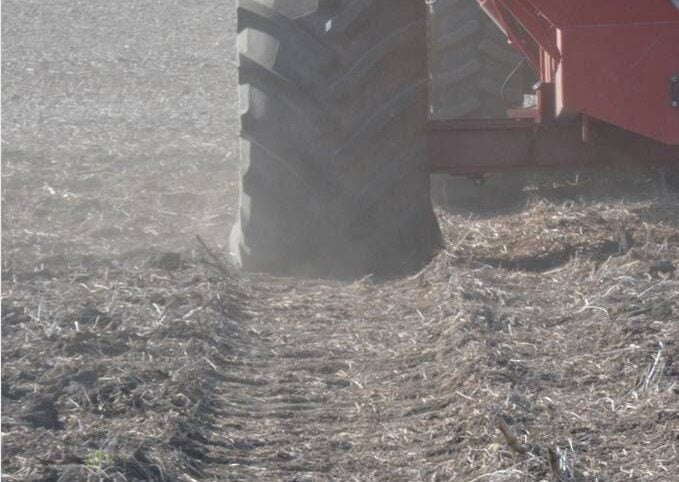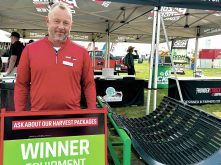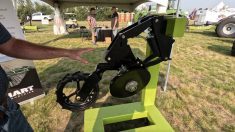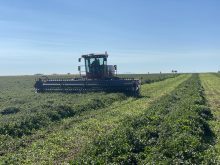It seems farm equipment keeps getting bigger and bigger. Grain carts are no exception, with the largest models now closing in on 3,000 bushels of grain capacity.
Scott Shearer, chair of the department of food, agricultural and biological engineering at Ohio State University, spoke about the compaction consequences of supersized grain carts at the CropConnect 2025 conference held in Winnipeg in February and in a subsequent interview with Grainews.
“If we go back to, say, the 1990s, it was not uncommon to see farmers with 500- and 600-bushel grain carts,” he says. Shearer has witnessed a steady increase in size since then, with a 2,500-bushel grain cart the biggest one he’s seen.
Read Also

Claas brings 1000 Series SP forage harvesters to Canada
In mid-August, Claas unveiled its new line of Jaguar forage harvesters at an event in Visalia, California, deep in the heart of that state’s dairy region.
“We’ve seen a trend for increasingly larger grain carts almost year after year. That’s what the manufacturers offer and that’s what the farmers buy and use. Then obviously, there are these grain carts that roll over in the used market and those are getting bigger, too.”
Field traffic from such massive machinery can cause soil compaction problems that may reduce yields for the following crop — and it’s one reason why there’s a growing movement toward track-equipped grain carts.
READ MORE: Keep tire pressure low, vigilance high
“I see a lot more coming out with tracks on them now than I do wheels, especially when you get into the very high-volume grain carts,” Shearer says.
Grain carts can still cause compaction and yield reduction regardless of whether they’re on tracks or wheels, but Shearer’s research at Ohio State indicates there may be less of a yield hit with tracks compared to wheels in unfavourable soil conditions.
Shearer noted farmers can now choose between multiple track options and tire technologies, such as IF (increased flexion) or VF (very high flexion) tires, to limit the impact of grain cart traffic — but he stresses “that does not eliminate the concern for compaction.

“I think it’s important to remind people that compaction occurs because of gross vehicle weight,” he says. “The higher the gross vehicle weight, the greater the concern.”
Shearer says he believes really large grain carts are likely the worst culprit for compaction damage from field equipment — describing the biggest ones as “phenomenal” compaction devices due to their sheer size and weight.
“It concerns me greatly because we’ve gotten up to 2,500 bushels on some of these larger grain carts. When you consider the base weight of the grain cart and then add 2,500 bushels at 60 pounds per bushel, it could be 95 tons.”
READ MORE: Farmers assess the effects of soil compaction
One way new track and tire technologies address compaction is by distributing all this weight over a broader surface area. However, Shearer says, this can lead to problems with compaction deeper down in the soil.
“If we look at track or tire soil contact pressures, they can be relatively low. But it’s the fact that you spread pressure out over a very large area that drives the compaction deeper into the soil,” he says.
“It used to be we were concerned about compaction that might have occurred 15 to 18 inches deep in the soil … If you get a wet harvest, we can see that compaction being driven down as deep as 30 to 40 inches,” Shearer says. “We’re probably starting to see an accumulation of that effect, as equipment continues to grow larger.”
Shearer suggests that’s likely a larger concern for farmers in his home state of Ohio than in the Prairie provinces, where deeper frost levels during winter can help mitigate compaction problems caused by farm machinery the previous season.
Chasing the combine
One important reason grain carts are getting larger is to increase the efficiency of harvesting operations — which is why you’ll often see grain carts following combines up and down the field, loading up with grain on the go in order to maximize harvest capacity.
And combine harvesters, Shearer notes, are also getting bigger and more powerful — some approaching 800 horsepower — which often means grain tanks on combines fill up faster and need to be emptied more frequently.
“With smaller grains with lower yields, you can probably go a little further between combine unloading,” Shearer says. “But at least here in the States, with high-yielding corn, it’s only going to take four minutes to fill the grain tank on the combine.”
When grain carts chase combines this way it can increase the compaction risk, he says, especially in soggy fields during difficult harvests.
“Generally, compaction is going to occur when the soils are wetter. If you have extremely dry soils, I don’t really care how big the grain cart is,” Shearer says. “Here in the States, we get into situations later in the fall when the soil profile begins wetting back up, and that’s when I really get concerned about large grain carts.”
Shearer says he understands sometimes farmers have no choice but to send out their combines and grain carts in tough harvest conditions, as there are always other considerations, such as a tight harvesting window or paying off end-of-year farms bills.
Those operating grain carts should try to stay on the same field tracks if they can, he says, as this can help mitigate compaction damage.
“If you decide not to go in the same track thinking you’re doing yourself a favour, what you’re really doing is more damage to a greater area of the field,” he says.
“What we have seen is when we make repeated passes on the same track, generally the first pass does about 85 per cent of the damage,” Shearer adds. “Subsequent passes certainly add a little bit, but it’s going to be a marginal increase, maybe 10 to 15 per cent in yield reduction as the compaction penalty.”
Shearer has another piece of advice for those shopping for a new grain cart. He recommends farmers try to resist the temptation to buy something really big and instead opt for an appropriately-sized cart better suited for their operation.
“You want to be careful that you don’t go larger than needed,” Shearer says, adding smaller grain carts not only save farmers money but also can reduce field operation difficulties and compaction risks during tough harvest seasons.
















